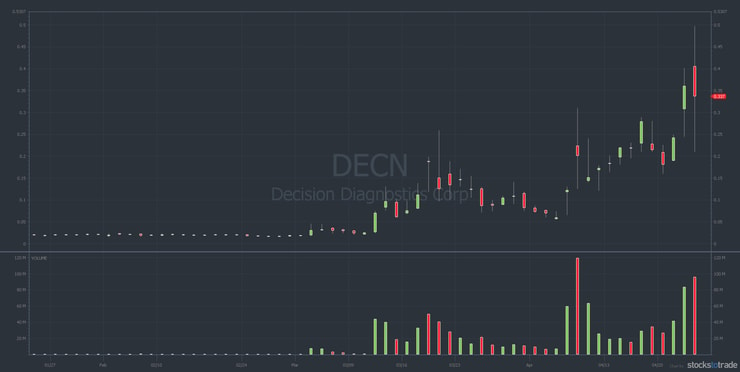One of my greatest assets is understanding that successful trading is a moving target. It’s a lesson you should burn into your brain.
From the beginning of my trading career right up to the present I’ve adapted to the shifting market. At first, I traded breakouts. Then when the bubble burst, I adapted. That’s how I shorted my way to my second million.
But then things changed. I recognized I could do better by focusing on long patterns. And at some point, I might have to adapt … again. This is an important lesson. It can save you a ton of self-inflicted pain.
Right now the market’s a little choppy. You have to get in tune with it. Once you really understand it’s a moving target it gets easier.
More about that later in this post. First…
Table of Contents
- 1 My Shelter-In-Place Update
- 2 Questions from Students
- 2.1 “Tim, I’m getting consistent with one pattern. Should I start working on new patterns?”
- 2.2 “Your DECN trade on April 21 looks obvious in hindsight. What was your thought process?”
- 2.3 Buy the Rumor, Sell the News
- 2.4 StocksToTrade Feature of the Month: Breaking News Chat
- 2.5 Even Morning Panics Are Moving Targets
- 3 Trading Lesson of the Week
- 4 Millionaire Mentor Market Wrap
My Shelter-In-Place Update

2025 Millionaire Media, LLCI’m still chillin’ in Los Angeles — just trying to keep up with the markets.
One positive thing about being stuck in one place is I’m getting a lot of work done. With my team’s help, I’m working hard to create as much quality content as possible. I want you to have as much information as possible.
So take advantage of everything I’m putting out there for you…
First, if you haven’t seen it yet, sign up for free access to my “Volatility Survival Guide.” It’s a must-see guide in the current market environment.
Also…
- Join my Facebook group 2020 Stock Market Updates With Tim Sykes for daily updates.
- Follow me on Twitter for motivation and to see how my students are doing in the market.
- Subscribe to my YouTube channel. Lately, I’ve been putting up videos almost daily.
Let’s get right to some…
Questions from Students
“Tim, I’m getting consistent with one pattern. Should I start working on new patterns?”
Always test new setups. Even if you have one or two patterns that work really well.
Think of it like a successful company doing research and development (R&D). They allocate a percentage — 10%, 20%, 30% — to new technologies. Even if they never pan out.
Let me give you an example…
Successful software-as-a-service (SaaS) companies spend 23% of revenue on R&D.
We’re talking well-known companies like DropBox, DocuSign, and Salesforce. Why would they do that? Why not just sit back and collect profits from their successful products?
Business, like trading, is a moving target. What happens if a competitor comes up with a better, faster, and less expensive service? It happens all the time with SaaS. So they’re constantly trying to come up with the next version. A better service. Faster and more reliable platforms.
So as a trader that’s how you have to think. Because what happens if the one or two patterns that you’re really good at … stop working?
All traders adapt.
My Trading Moving Target
I made over $1 million back in ‘99 and 2000 buying penny stock breakouts.** But then the markets changed. I had to adapt. My second million came from short selling.
A lot of people made money during the bubble. But when the bubble burst, they lost it all or they made nothing because they didn’t adapt.
“A trader’s ability to adapt to changing market conditions is the key to successful trading.”
— “An American Hedge Fund”, page 95
For an in-depth understanding of my experiences as a young trader, get a copy of “An American Hedge Fund.” It will help you understand just how much of a moving target the stock market is.
My ability to remain profitable for 20 years hinges on my ability to adapt. The same goes for helping so many students. I had to adapt. And my students had to learn to adapt.
Watch this video to learn…
How My Top Students Became Self-Sufficient
So adapt or perish.
“Your DECN trade on April 21 looks obvious in hindsight. What was your thought process?”
First, I actually traded Decision Diagnostics Corp. (OTCPK: DECN) twice last week.
Also, the SEC halted trading on DECN on April 24. Sketchy, I know. It’s an example of why you should always expect the worst from these companies.
The second trade on April 23 was the best morning panic so far this year. It was kinda crazy. Let’s take a look at that first trade…
Decision Diagnostics is reportedly developing a home test kit for coronavirus. So the stock has been in play several times since mid-March.
Here’s the DECN three-month chart:

It’s a former runner. I underestimate plays all the time. I’ve underestimated DECN … maybe half a dozen times now. Thing is, it’s a very choppy stock. Not my typical favorite kind of stock. I prefer higher-priced stocks and clean patterns. Also, lower-priced stocks have been failing overnight.
More Breaking News
Buy the Rumor, Sell the News
On April 21, the company announced a ‘scheduled update’ about its home testing kit. The date it gave was April 23. So this is a classic case of buy the rumor, sell the news.
Check out the DECN chart from April 21–23:

Check out the price action over those three days. As you can see, I underestimated the stock both times. But even when I underestimate, I can still profit. That’s why it’s so important to adapt AND understand that trading is a moving target. More on that later in this post…
Hint: pay attention to the StocksToTrade news notifications on the chart — the two green callouts numbered 1 and 2. Those are news alerts available on every chart. They clued me into the news I needed to take those trades. But STT is taking it to the next level.
(Quick disclaimer: I helped design and develop StocksToTrade.)
Check this out…
StocksToTrade Feature of the Month: Breaking News Chat
I’ve been trading for 20 years. So I have a lot of experience interpreting the news fast. StocksToTrade recently added one of the coolest features I’ve ever seen: the Breaking News Chat.
There are two analysts on the team monitoring hundreds of news feeds, Twitter, and online forums. When one of them sees actionable information they quickly alert the Breaking News Chat. It’s available to STT subscribers as an add-on.
StocksToTrade lead trainer Tim Bohen is so stoked about it he’s calling it the feature of the month. If you’re not using StocksToTrade … you should be. If you’re already using it, you can request it as an add-on when you log in to your account on the STT website.
Let’s get back to morning panics…
Even Morning Panics Are Moving Targets
Be sure to read my post from last week: How I Called the Best Morning Panic So Far This Year. It lays out the morning panic pattern in detail. That’s an important post if you really want to understand morning panics.
One point I made to my students in my webinar last week was that you can’t predict exactly what will happen. You have to adapt. One student mentioned waiting for DECN to drop to 30 cents a share the next day.
I reminded them that the target you want is irrelevant. Take what the market gives you. I even said, “What if it drops all the way to 20 cents a share?” And that’s exactly what it did. Again, I wasn’t guessing or predicting. I was trying to drive home the point: successful trading is about recognizing it’s a moving target.
When you’re ready to learn the nuances of morning panic dip buys … I have 547 morning panic video lessons. Plus, there are 659 dip buy video lessons. You can get access one of two ways:
Apply for my Trading Challenge. Not everyone who applies gets accepted. You have to be dedicated and ready to work your butt off.
Subscribe to Pennystocking Silver. It’s not as comprehensive as Trading Challenge — you don’t get the live webinars. But you can watch all the morning panic and dip buy video lessons and learn my thought process. That way you can potentially take advantage of my favorite pattern.
The bottom line about my DECN trades…
I like playing it safe and underestimating. I’ll take singles all day long. Again, it’s a matter of understanding the…
Trading Lesson of the Week

2025 Millionaire Media, LLCLately we’ve been seeing a lot of choppy moves. Early in the coronavirus crisis it was pretty easy. There were mask plays like Alpha Pro Tech Ltd. (NYSE: APT). Or vaccine plays like Inovio Pharmaceuticals (NASDAQ: INO).
But now, several weeks in … the market’s gotten kinda tired. And the SEC has suspended several stocks. For example, No Borders, Inc (OTCPK: NBDR) and Predictive Technology Group, Inc (OTCPK: PRED). Then last week DECN got halted.
You have to be careful with these plays. It doesn’t matter whether you like holding overnight or trading them intraday. Be safe.
So the lesson is…
Successful Trading Is a Moving Target
It’s not the same market it was a few weeks ago. There are still a lot of plays, but I’m taking smaller position sizes. I don’t wanna risk big losses.
So you have to adapt — not just to changing patterns but also to changing markets. And that’s what this is, a moving target. You have to try to get in tune with the right position sizes, the right market … the right sector, and the right pattern.
It sounds like a lot, but it gets easier the longer you’re in the game.
Millionaire Mentor Market Wrap
That’s another update in the books.
Whatever you do, trade safely in this market. When I don’t see anything worth trading I don’t trade. Sometimes the best trade is no trade.
And even when I take speculative trades, I always follow rule #1: cut losses quickly.
Finally, don’t get attached to any one stock or any trade. Remember, successful trading is a moving target. Learn it. Put it into practice. Along with cutting losses quickly, it can greatly increase your chance of success.
What do you think about successful trading being a moving target? Do you agree? Even if you’re new to trading, comment below. I love to hear from all my readers!












Leave a reply